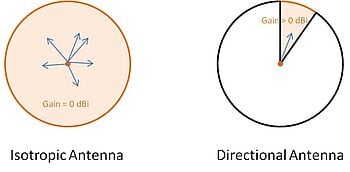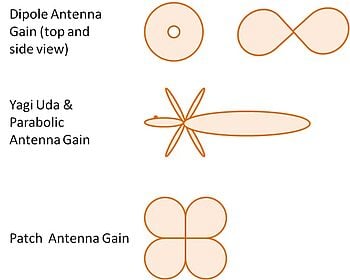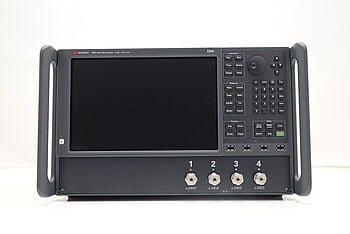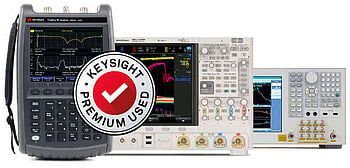- Introduction
- Parabolic Antenna Gain Calculator
- Formulas used in the calculator
- Master the Art of Antenna Gain Calculation
- TL;DR
- Understanding the Basics of Antenna Gain
- The Antenna Gain Calculation Formula
- Antenna Gain in Different Types of Antennas
- 4 Practical Applications of Antenna Gain
- 3 Misconceptions About Antenna Gain
- Glossary of Terms
- Why Choose Keysight for Your Wireless Communication Needs
- Final Thoughts from the Keysight Used Store
- Whenever You’re Ready, Here Are 5 Ways We Can Help You
- Popular Used Oscilloscopes
Parabolic Antenna Gain Calculator
This calculator determines the gain of a parabolic antenna based on its specifications.
Formulas used in the calculator
\(Gain = 10 \log 10 E \left(\frac{\pi d}{\lambda}\right)^2\), where
E = Efficiency (decimal number)
d = diameter (m)
λ = wavelength = c/f, where c = speed of light, f = frequency
Beamwidth = 70d, where:
70 = k = parameter specific for a type of antenna.
Note that the value of 70 for the beamwidth parameter "k" is an approximation and may vary depending on the specific design and application of your antenna. Antenna characteristics can be more accurately determined through electromagnetic simulations and measurements. Also, there are various antenna designs and types beyond those mentioned above, and their beamwidths can differ significantly.
Focal Length = D216d, where:
D = depth (if D = d/2, formula simplifies to d/8)
This factor is not considered for simplicity.
Effective Aperture = 2*Gain4 = Ed24

 Antenna Gain Calculation Cheat Sheet
Antenna Gain Calculation Cheat Sheet
Download for Free With a Keysight Used Equipment Store Account
Master the Art of Antenna Gain Calculation
"Antenna gain determines the range and strength of a wireless signal. It's the difference between communicating with someone in the next room or reaching someone across the globe. Truly, antenna gain is a key player in wireless communication systems," notes Professor Y.T. Lo, co-author of 'Antenna Handbook: Theory, Applications, and Design'.
Imagine for a moment, a world where phones or Wi-Fi routers stop working. Daily communication collapses, streaming becomes impossible, and important work emails hang in limbo. The marvel of wireless communication, which we all take for granted, has a fundamental secret hidden within the framework of antenna design – antenna gain.
For electrical engineers who design or use wireless systems, understanding antenna gain is not merely an option but a necessity. It is the linchpin in the machinery of wireless communication that controls signal strength, range, and quality.
When it comes to efficient signal transmission and reception, every bit of gain matters, making it an imperative part of your toolkit whether you're enhancing the signal strength of a home Wi-Fi network or deploying an extensive cellular infrastructure.
When you master the art of antenna gain calculation, you unlock a new level of performance in wireless communication. Let's explore how you can gain mastery over this critical component of wireless engineering.
TL;DR
- Antenna gain is a critical concept in wireless communication. Represented by 'G', it measures the efficiency of an antenna to direct energy in a specific direction. The formula for calculating antenna gain is G = 10 log (P2/P1).
- Antenna gain is pivotal in different types of antennas like dipole, Yagi-Uda, parabolic, and patch antennas. Understanding it is crucial for designing efficient wireless communication systems.
- Practical applications of antenna gain include Wi-Fi routers, satellite TV, mobile communication, and radio astronomy. Knowledge of antenna gain leads to improved signal quality, extended range, efficient power usage, and customized coverage.
- To use antenna gain accurately, it's important to understand and correct common misunderstandings. For example, antenna gain does not increase power or provide equal coverage in all directions. Keysight Technologies offers tools and solutions, like the antenna gain calculator, which help engineers and wireless communication professionals apply their knowledge to real-world situations.
Understanding the Basics of Antenna Gain
In simple terms, antenna gain is the measure of an antenna's ability to direct or concentrate radio frequency energy in a particular direction. It’s a reflection of how well the antenna focuses energy from a specific direction as opposed to all directions equally.
Antenna gain is usually denoted by the symbol 'G'. The unit of measurement for antenna gain is the decibel (dB), specifically dB relative to an isotropic radiator (dBi). An isotropic radiator is a theoretical or 'point source' antenna which radiates power uniformly in all directions.

The importance of antenna gain in wireless communication cannot be overstated. High-gain antennas can transmit and receive signals over greater distances or focus them more efficiently in a chosen direction. They are a vital component in the design and installation of wireless communication systems, significantly affecting their range, signal strength, and overall performance.
For example, in a Wi-Fi router, a high-gain antenna can provide a stronger signal over a larger area, offering better connectivity for devices. Similarly, in mobile communication, antenna gain can greatly influence the reception quality and range of cellular signals.
| Key Takeaway |
|---|
| Antenna gain (G) measures how well an antenna directs energy in a certain direction. Understanding and calculating it properly can significantly improve the performance and reliability of any wireless communication system. |
The Antenna Gain Calculation Formula
The gain of an antenna is generally calculated using the following formula:
G = 10 log (P2/P1)
In this formula:
- G is the gain of the antenna
- P2 is the power output in the desired direction
- P1 is the power that would be transmitted if the energy were distributed equally in all directions (isotropic radiation).
This formula enables us to calculate the gain in decibels (dB) of an antenna compared to an isotropic radiator.
Each component in the formula carries significant meaning:
- G: Gain is the comparative measure of an antenna's ability to focus energy in a specific direction. It's essential for understanding how efficiently an antenna operates.
- P2: The power output in the desired direction gives us an understanding of how effective the antenna is at directing energy.
- P1: This component represents the theoretical isotropic radiation, providing a standard to measure against and ensuring our calculations are grounded in a universal comparison.
Table: Components of the Antenna Gain Calculation Formula
| Component | Significance |
|---|---|
| G | Measures the antenna's ability to focus energy in a specific direction. |
| P2 | Represents the power output in the desired direction, indicating how effectively energy is directed. |
| P1 | Theoretical isotropic radiation; provides a universal comparison standard. |
Key factors that affect the antenna gain:
- Design of the Antenna: Different designs have varying abilities to direct radio frequency energy. For example, Yagi, parabolic, and horn antennas are high-gain antennas.
- Frequency of Operation: Antenna gain varies with the frequency of the transmitted or received signal. It's vital to optimize antenna design for the specific frequency range in use.
- Antenna Size: Larger antennas can often focus energy more effectively, resulting in higher gain.
- Antenna Material: The material used in the antenna can affect its ability to conduct radio frequency energy, thereby impacting the gain.
- Antenna Placement: The placement of the antenna, including height above ground and surrounding environment, can affect gain, particularly in real-world, challenging environments.
Remember, calculating antenna gain accurately is crucial for effective wireless communication system design and implementation.
Antenna Gain in Different Types of Antennas
The antenna gain differs significantly across various types of antennas due to their distinctive designs. Here's how the antenna gain works in some of the most common types of antennas:
- Dipole Antennas: These antennas have a gain of around 2.15 dBi. They radiate equally in all directions perpendicular to the axis of the antenna, creating a doughnut-shaped radiation pattern.
- Yagi-Uda Antennas: These are directional antennas, providing higher gain (6-20 dBi). The gain increases with the number of elements used in the antenna design. The radiation pattern resembles a beam, focused in a specific direction.
- Parabolic Antennas: Also known as dish antennas, these are high-gain (up to 30 dBi or higher) and highly directional antennas. They have a large parabolic reflector that focuses the signal into a narrow beam.
- Patch Antennas: These are commonly used in mobile devices and Wi-Fi routers with a moderate gain of around 6-9 dBi. They are compact and efficient for specific directions.

To calculate the antenna gain for different types of antennas, follow these steps:
- Identify the type of antenna and its specific design characteristics.
- Determine the frequency of operation.
- Apply the antenna gain formula: G = 10 log (P2/P1).
- For P2, use the power output in the desired direction for the specific type of antenna.
- For P1, use the power of isotropic radiation, i.e., the power that would be transmitted if the energy was distributed equally in all directions.
- Calculate the gain and express it in dBi (decibels relative to isotropic).
| Key Takeaway |
|---|
| Each antenna type – dipole, Yagi-Uda, parabolic, and patch – has unique gain characteristics. Understanding these characteristics and how to calculate antenna gain is instrumental in optimizing the design of wireless communication systems. By determining the frequency of operation and applying the gain formula, you can effectively tailor your antenna selection and design to your specific wireless communication needs. |

 Antenna Gain Calculation Cheat Sheet
Antenna Gain Calculation Cheat Sheet
Download for Free With a Keysight Used Equipment Store Account
4 Practical Applications of Antenna Gain
Antenna gain plays a central role in designing efficient wireless communication systems. The ability to focus energy in a specific direction facilitates long-distance communication, enhances signal quality, and optimizes power usage. Here are some practical applications of antenna gain:
- Wi-Fi Routers: A high-gain antenna in a Wi-Fi router can provide a stronger signal over a larger area, offering better connectivity for devices. For example, a directional antenna (like a Yagi antenna) can be used to focus the Wi-Fi signal in one particular direction, extending the range where it is needed the most.
- Satellite TV: Dish antennas (parabolic antennas) are used because of their high gain. They focus the signal into a narrow beam towards the satellite, enabling reception of weak signals from far-off satellites.
- Mobile Communication: Antenna gain significantly influences the reception quality and range of cellular signals. For instance, cell phone towers use high-gain antennas to transmit and receive signals over large areas.
- Radio Astronomy: Antenna gain is critical in radio telescopes used for astronomy. These parabolic antennas can capture weak signals from distant cosmic sources, thanks to their high gain.
Table: Practical Applications of Antenna Gain
| Application | Role of Antenna Gain |
|---|---|
| Wi-Fi Routers | Enhances signal strength over a larger area. |
| Satellite TV | Enables reception of weak signals from distant satellites. |
| Mobile Communication | Increases reception quality and range of cellular signals. |
| Radio Astronomy | Facilitates capture of weak signals from distant cosmic sources: |
Key benefits of understanding antenna gain in wireless communication:
- Improved Signal Quality: By focusing energy in the desired direction, antenna gain can enhance the quality of received signals, reducing errors and improving data rates.
- Extended Range: High-gain antennas can transmit and receive signals over larger distances, making them ideal for applications where devices are far apart.
- Efficient Power Usage: Antennas with good gain provide more efficient use of power, focusing the available energy in the required direction rather than wasting it in unwanted directions.
- Customized Coverage: Engineers can design systems with custom coverage patterns to meet the specific needs of the application.
3 Misconceptions About Antenna Gain
When it comes to antenna gain, there are several misconceptions that can cause confusion. Let's take a look at some of these common misunderstandings and provide accurate information:
1. Misconception: Higher antenna gain increases power.
Correction: Antenna gain does not increase the total power transmitted by an antenna. It merely focuses the energy in a particular direction. Think of it as focusing the beam of a flashlight. The battery (power source) remains the same, but the light (energy) is more focused.
2. Misconception: Antennas with high gain provide better coverage in all directions.
Correction: Antennas with high gain concentrate the signal in a specific direction. While this improves range and signal strength in that direction, it reduces coverage in other directions. In contrast, antennas with lower gain distribute their signals more evenly around the antenna.
3. Misconception: Antenna gain determines the quality of reception.
Correction: While antenna gain can affect signal strength, it's not the only factor that affects reception quality. Other factors, such as the frequency of operation, interference, and the design of the receiver circuitry, also play significant roles.
| Key Takeaway |
|---|
| Misunderstandings about antenna gain are common, but having a clear understanding of this crucial concept can significantly enhance your proficiency in wireless communication. Antenna gain is about direction and concentration of signal, not about power amplification. Getting this right will allow you to make the best decisions when designing and implementing wireless communication systems. |

Glossary of Terms
Understanding the terminology used in discussions about antenna gain is essential for a comprehensive understanding and practical application of the concept. Here are some key terms, their definitions, and examples:
- Gain: The ability of an antenna to focus energy in a specific direction compared to an isotropic radiator. For example, a high-gain antenna focuses more energy in one direction, enhancing the signal strength in that direction.
- Decibel (dB): A unit used to express the ratio of two values of a physical quantity, often power or intensity. In the context of antenna gain, it's used to compare the power produced by an antenna to the power produced by an isotropic radiator.
- dBi: Decibels relative to isotropic. This is a measure of the gain of an antenna compared to an isotropic radiator, which is a theoretical antenna that distributes energy equally in all directions.
- Isotropic Radiator: A theoretical antenna that radiates power uniformly in all directions. It's used as a reference to measure an antenna's gain.
- Directional Antenna: An antenna that radiates and receives energy more efficiently in some directions than others. Examples include Yagi, parabolic, and patch antennas.
| Key Takeaway |
|---|
| Familiarizing yourself with the key terminology used in antenna gain discussions is instrumental in comprehending and effectively applying the concept in real-world applications. By understanding these terms, you'll be better equipped to design and implement efficient wireless communication systems. |
Keysight Technologies stands out for its innovative solutions, extensive expertise, and tools, including our premium used network analyzers and oscilloscopes to measure antenna gain.
Here are some reasons to choose Keysight:
- Precision: Keysight's tools like network analyzers, oscilloscopes and signal generators offer accurate results, helping to enhance the efficiency of your wireless communication design.
- Comprehensive Solutions: Keysight provides a suite of solutions supporting various aspects of wireless communication.
- Expert Support: With Keysight, you have the support of a team of experts who can help you use their tools effectively and get the most out of your investment.
- Innovation: Keysight is committed to innovation, regularly updating and upgrading their tools to keep up with the fast-paced evolution of wireless technology.

Final Thoughts from the Keysight Used Store
Mastering the art of antenna gain calculation is a critical skill for professionals in the field of wireless communication. From understanding the importance and misconceptions of antenna gain to exploring its practical applications and the crucial role it plays in different types of antennas, we've covered a broad spectrum of the topic.
Keysight Technologies equips you with precision tools like the antenna gain calculator, enabling you to apply this knowledge practically in your projects. Our comprehensive solutions support various facets of wireless communication, including signal generation, analysis, and network testing. Coupled with the expert guidance of our team, engineers can fully leverage these tools to optimize their wireless designs.
We encourage you to further explore Keysight's extensive resources and cutting-edge equipment. Whether you're working on Wi-Fi routers, satellite TV, mobile communication, or radio astronomy, Keysight's offerings can enhance your ability to create efficient, high-performing wireless communication systems.

Whenever You’re Ready, Here Are 5 Ways We Can Help You
- Browse our Premium Used Network Analyzers.
- Call tech support US: 1 800 829-4444 Press #, then 2 Hours: 7am – 5pm MT, Mon– Fri
- Talk to our sales support team by clicking the icon (bottom right corner) on every offer page
- Create an account to get price alerts and access to exclusive waitlists
- Talk to your account manager about your specific needs
Popular Used Oscilloscopes
Keysight Used Oscilloscopes offers a wide range of industry leading pre-owened oscilloscopes, ranging from older generation Agilent oscilloscopes to the newest Keysight oscilloscope models. So whether you are a fist time buyer, replacing a model like-for-like or looking for upgrade – we have something for you.